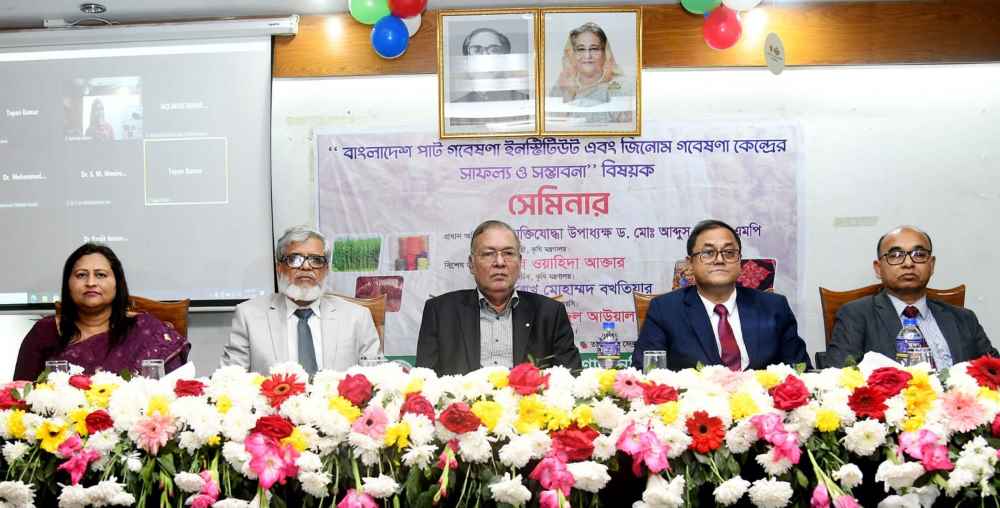
Minister of Agriculture Dr. Md. Abdus Shaheed said 3-4% foreign exchange is earned by exporting raw jute and jute products, which is worth US$ 1.20 billion. The jute sector contributes 1.4% to the country’s GDP and the jute sector contributes 26.26% to the agricultural GDP. Jute is the second most important fiber in the world after cotton.
Addressing the chief guest at the seminar, the Agriculture Minister said, “I am happy to learn about the progress of BJRI and genome research, especially the 56 high yielding jute and jute fiber crop varieties developed by BJRI scientists and 223 technologies developed by BJRI from attending this seminar.
He said, “To bring back the green glory of jute, the current government has recently declared jute as an ‘agricultural commodity’ and the Hon’ble Prime Minister has declared jute and jute products as ‘product of the year 2023’.”
Jute is the second most important fiber in the world after cotton. Bangladesh’s jute ranks first in jute production and jute export in the world. 40-50 lakh farmers in Bangladesh are directly and indirectly involved in jute production. 14.5-16.2 lakh tonnes of jute and jute fibers were produced in 7-8 lakh hectares of land in 2010 and thereafter. In the financial year 2021-22, 15.02 lakh tonnes of jute was produced on 7.45 lakh hectares of land.
He also said, “Agriculture as a whole is the most powerful source of raw material supply from food security to industry.” As an agricultural product, jute exports 282 types of products in the world. Bangladesh now accounts for 72 percent of the global export earnings of the jute sector.
Executive Chairman of Bangladesh Agricultural Research Council (BARC) was present as a special guest in the seminar. Sheikh Mohammad Bakhtiar and Joint Secretary (Research Division) Ministry of Agriculture Rehana Yasmin. The seminar was chaired by Dr. Md. Abdul Awal.
In the President’s speech, the Director General of BJRI said, “Hon’ble Prime Minister has promised in the election manifesto 2024, ‘The demand for jute and jute products is increasing worldwide due to environment-friendly considerations. Jute products will be diversified to take advantage of this opportunity and initiatives to make jute industry profitable will continue. Private sector initiatives in jute industry will be encouraged’. Bangladesh Jute Research Institute is determined to implement this commitment. As part of this process, 173 research trials on jute variety development and other agricultural technology innovations and 54 on jute multipurpose products and industrial technology innovations are being implemented in 2023-24. During the current government (from 2009 till date) Bangladesh Jute Research Institute has developed a total of 16 varieties (Desi jute 6, Tosha jute 4, Kenaf 3 and Mesta 3), 73 agricultural technologies and 35 industrial and technical technologies,” said Dr. Awal.
The research coordinator of Genome Research Department informed the guests about the progress of genome research activities and visited the laboratory of the research center. Kazi Md. Mosaddek Hossain. Director of Administration and Finance Wing of BJRI presented about the success and potential of BJRI’s research activities. S. M. Mahbub Ali
451 bacteria have already been identified through sequencing from the jute wake to complete the jute decomposition process in the fastest time in less water. By using the combination of bacteria, it has already been possible to decompose 15 kg of jute in 12 days in the lab and greenhouse. Research is ongoing to make the technology more suitable for widespread use at the farmer level.
The seminar was also attended by BJRI technical wing director Eng. Md. Moslem Uddin, jute textile wing director Dr. Ferdous Ara Dilruba, Director of Agriculture Wing. Nargis Akhter, Director of PTC Wing. Mahmud Al Hussain BJRI scientists and officials at all Levels.



